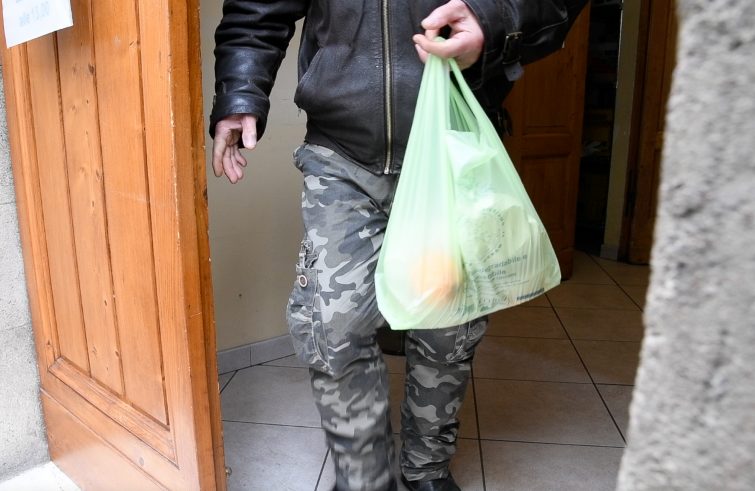
A person born into a poor family in Italy will climb the social ladder after five generations (the OECD average is 4.5 years). This is known as “intergenerational” or “hereditary” poverty and is referred to metaphorically as sticky grounds and sticky ceilings, i.e. conditions that keep young people stuck in social hardship. Six in ten Caritas beneficiaries are the result of ”intergenerational poverty”, meaning that they are stuck on ”sticky floors”. Almost 1 in 3 of those born to parents with no qualifications only have a primary school certificate. There were 5.6 million individuals (9.4% as last year, equivalent to 1,960,000 households) living in absolute poverty in Italy last year, 1.4 million of whom were children (source: ISTAT). Italy ranks last among industrialised countries in terms of social and educational mobility: only 8% of young people whose parents lack a higher education qualification have a university degree (the OECD average is 22%). By contrast, this figure rises to 65% among the offspring of university graduates (OECD data). The opportunities for those born into families at the bottom of the social ladder decreased in 2021: 28.9% of them were bound to remain in the same social position as their parents. In Europe, Italy holds the sad record of NEETS: 3 million young people aged 15-34, or 25.1% of the total, are neither studying nor working. These are some of the figures published in the 2022 Report on Poverty and Social Exclusion in Italy titled “The Weakest Link”, drawn up by Caritas Italy and presented today in Rome.
1.5 million Caritas interventions, +7.7% new beneficiaries. Caritas outreach centres and diocesan Caritas branches offer valuable insight into poverty patterns in Italy. Almost 1.5 million aid packages were provided by 192 diocesan Caritas in 2021. At least 227,556 people relied exclusively on support from Caritas network services operating in 192 dioceses. There has been a 7.7% increase in the number of new beneficiaries, mostly foreigners, compared to 2020. Not all of them are new poor but people slipping in and out of situations of hardship. Both men (50.9%) and women (49.1%) have sought help. The proportion of non-Italian citizens is growing (55%), with peaks of 65.7% and 61.2% in the North-West and North-East of Italy. Conversely, in the South and the Islands, Italians constitute the largest percentage (68.3% and 74.2%). The average age of beneficiaries is 45.8 years.
The number of homeless persons detected in 2021 totalled 23,976, or 16.2 per cent of the total number:
mostly men (72.8%), foreign nationals (66.3%), unmarried (45.1%), with an average age of 43.7 years. Most of them were in centres located in the North. 54.5% of Caritas beneficiaries reported two or more areas of vulnerability, including financial, occupational, housing, family, health, immigration-related problems, etc.
74.7% of Caritas support concerned material goods and services ( soup kitchens/ canteens, distribution of food parcels, vouchers, personal hygiene products, showers, etc.);
7.5% involve counselling, simple or with discernment; 7.4% concern shelter, long or short term; 4.6% financial subsidies (for the payment of rents and bills), 2.2% social welfare services and 1.5% health care.
Lower education, greater poverty. Compared to the previous year, Caritas registered higher rates of poverty among people with low levels of education, with an increased percentage of users with a middle school diploma only (from 57.1% to 69.7%). These include illiterate individuals with no qualifications or only a primary school certificate. In insular and southern regions, this figure reaches 84.7% and 75% respectively. Occupational situations are linked to education attainment, which is partly connected with the situation caused by the pandemic:
the proportion of unemployed or jobless persons rose from 41% to 47.1%; at the same time, the share of employed persons dropped from 25% to 23.6%.
Among Caritas beneficiaries, cases of intergenerational poverty account for 59.0%; in the Islands and in the Central regions this figure is even higher (65.9% and 64.4% respectively). More than 70% of fathers of Caritas recipients are employed in low-skill professions. The number of housewives is very high among mothers (63.8%), while most employed women have low levels of education.
One in five sons held the same occupational status as their fathers while 42.8% experienced “downward mobility.”
In contrast, more than a third (36.8%) experienced upward mobility in terms of occupational status but could not find a job that was commensurate with their studies.
Young people and jobs in Europe, a gloomy future? A survey conducted in 10 European countries in partnership with Caritas Europe and Don Bosco international shows a bleak future for young people when it comes to employment and education.
For at least four out of five students, the pandemic has adversely affected their plans for the future.
A survey conducted on a sample of young people in five countries showed that 41.3% of them experienced serious economic problems at home because of Covid; 44.1% received financial help to pay school fees; 37.4% did not feel adequately prepared to continue their studies; 57.1% did not feel qualified to enter the job market; 78.6% received no support of guidance at school as regards their future.
“Citizens’ income” – a form of non-individual guaranteed minimum income -, is granted to only 44% of the absolute poor. The measure has so far been granted to 4.7 million people, “but it only caters for less than half of the absolute poor (44%)”, the Caritas Report notes: “It is therefore necessary to make sure that the poorest people benefit from the scheme, starting with the absolute poor”. Moreover, “alongside the financial aspect of this provision, adequate social inclusion mechanisms must be in place”, currently hindered by “a number of administrative and operational constraints”. The report puts forward a number of proposals, including strengthening municipalities’ responsibilities, not least by increasing the human and financial resources available and improving project coordination.












